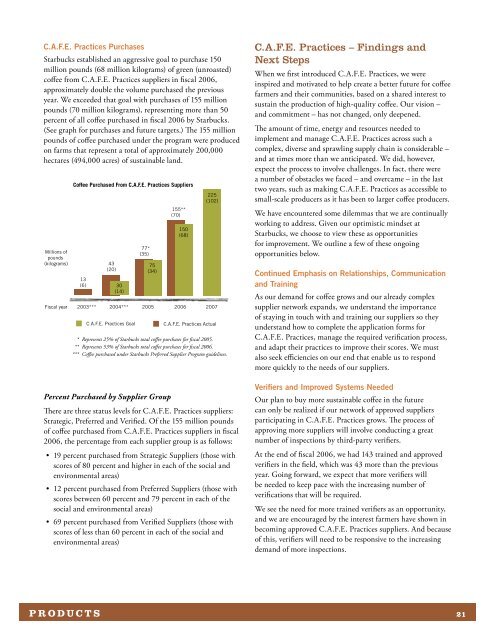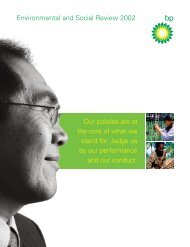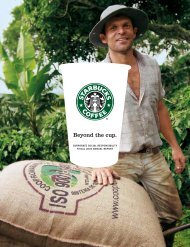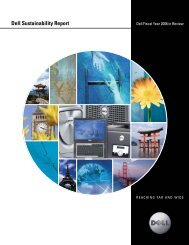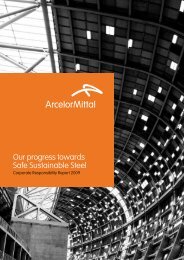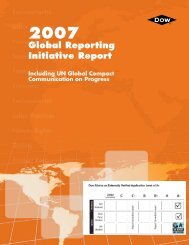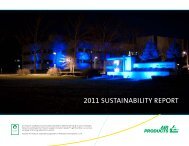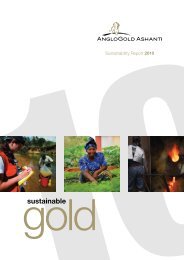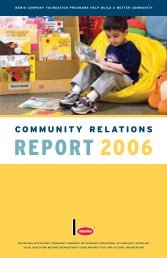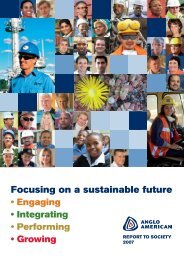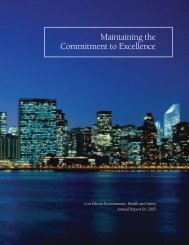Starbucks Corporation CORPORATE SOCIAL RESPONSIBILITY ...
Starbucks Corporation CORPORATE SOCIAL RESPONSIBILITY ...
Starbucks Corporation CORPORATE SOCIAL RESPONSIBILITY ...
You also want an ePaper? Increase the reach of your titles
YUMPU automatically turns print PDFs into web optimized ePapers that Google loves.
C.A.F.E. Practices Purchases<strong>Starbucks</strong> established an aggressive goal to purchase 150million pounds (68 million kilograms) of green (unroasted)coffee from C.A.F.E. Practices suppliers in fiscal 2006,approximately double the volume purchased the previousyear. We exceeded that goal with purchases of 155 millionpounds (70 million kilograms), representing more than 50percent of all coffee purchased in fiscal 2006 by <strong>Starbucks</strong>.(See graph for purchases and future targets.) The 155 millionpounds of coffee purchased under the program were producedon farms that represent a total of approximately 200,000hectares (494,000 acres) of sustainable land.Millions ofpounds(kilograms)Fiscal yearCoffee Purchased From C.A.F.E. Practices Suppliers13(6)43(20)30(14)C.A.F.E. Practices Goal77*(35)75(34)Percent Purchased by Supplier Group155**(70)150(68)225(102)2003*** 2004*** 2005 2006 2007C.A.F.E. Practices Actual* Represents 25% of <strong>Starbucks</strong> total coffee purchases for fiscal 2005.** Represents 53% of <strong>Starbucks</strong> total coffee purchases for fiscal 2006.*** Coffee purchased under <strong>Starbucks</strong> Preferred Supplier Program guidelines.There are three status levels for C.A.F.E. Practices suppliers:Strategic, Preferred and Verified. Of the 155 million poundsof coffee purchased from C.A.F.E. Practices suppliers in fiscal2006, the percentage from each supplier group is as follows:• 19 percent purchased from Strategic Suppliers (those withscores of 80 percent and higher in each of the social andenvironmental areas)• 12 percent purchased from Preferred Suppliers (those withscores between 60 percent and 79 percent in each of thesocial and environmental areas)• 69 percent purchased from Verified Suppliers (those withscores of less than 60 percent in each of the social andenvironmental areas)C.A.F.E. Practices – Findings andNext StepsWhen we first introduced C.A.F.E. Practices, we wereinspired and motivated to help create a better future for coffeefarmers and their communities, based on a shared interest tosustain the production of high-quality coffee. Our vision –and commitment – has not changed, only deepened.The amount of time, energy and resources needed toimplement and manage C.A.F.E. Practices across such acomplex, diverse and sprawling supply chain is considerable –and at times more than we anticipated. We did, however,expect the process to involve challenges. In fact, there werea number of obstacles we faced – and overcame – in the lasttwo years, such as making C.A.F.E. Practices as accessible tosmall-scale producers as it has been to larger coffee producers.We have encountered some dilemmas that we are continuallyworking to address. Given our optimistic mindset at<strong>Starbucks</strong>, we choose to view these as opportunitiesfor improvement. We outline a few of these ongoingopportunities below.Continued Emphasis on Relationships, Communicationand TrainingAs our demand for coffee grows and our already complexsupplier network expands, we understand the importanceof staying in touch with and training our suppliers so theyunderstand how to complete the application forms forC.A.F.E. Practices, manage the required verification process,and adapt their practices to improve their scores. We mustalso seek efficiencies on our end that enable us to respondmore quickly to the needs of our suppliers.Verifiers and Improved Systems NeededOur plan to buy more sustainable coffee in the futurecan only be realized if our network of approved suppliersparticipating in C.A.F.E. Practices grows. The process ofapproving more suppliers will involve conducting a greatnumber of inspections by third-party verifiers.At the end of fiscal 2006, we had 143 trained and approvedverifiers in the field, which was 43 more than the previousyear. Going forward, we expect that more verifiers willbe needed to keep pace with the increasing number ofverifications that will be required.We see the need for more trained verifiers as an opportunity,and we are encouraged by the interest farmers have shown inbecoming approved C.A.F.E. Practices suppliers. And becauseof this, verifiers will need to be responsive to the increasingdemand of more inspections.P R O D U C T S 21


